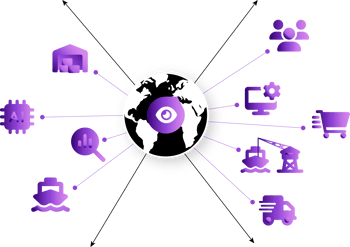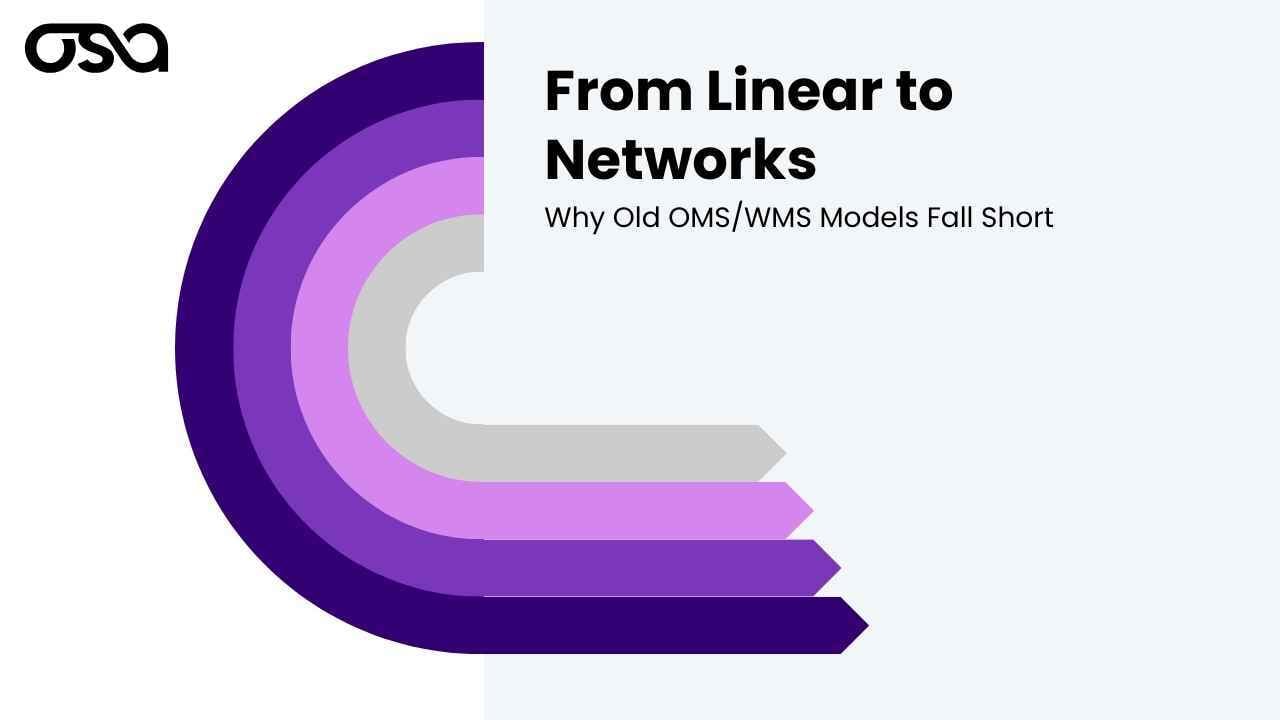Meeting the Challenges of Supply Chain Disruption
- Introduction Navigating Disruptions
- Section I Geopolitical Turbulence and Trade Uncertainties
- Section II Climate Change and Natural Disasters
- Section III Cybersecurity Risks in an Interconnected World
- Section IV Customer Expectations and Demand Volatility
- Section V Resilience Through Innovation and Collaboration
- Conclusion Be Resilient
Navigating Disruptions
Strategies to effectively navigate supply chain challenges to increase business readiness.
The last few years have proven to be a challenging time for global supply chains, as businesses grapple with a multitude of disruptions. From the lingering impacts of the pandemic to geopolitical tensions, natural disasters, and evolving customer expectations, supply chain professionals are facing complex and dynamic environments. Unfortunately for many businesses, supply chain disruptions can cause financial losses of 62%—impacting the bottom-line of many businesses.
Read on as we explore the critical issues that have characterized the supply chain landscape and discuss strategies and innovations to effectively navigate these challenges. By embracing resilience, adaptability, and forward-thinking approaches, businesses can overcome common disturbances and emerge stronger in the face of uncertainty.

Geopolitical tensions and trade conflicts create uncertainties that can disrupt global supply chains. In fact, 6 out of 10 major organizations believe that geopolitical instability will affect their supply chains in the next three years. Tariff disputes, trade restrictions, and shifting political dynamics impact the flow of goods, increase costs, and introduce regulatory complexities.
Amidst the complexities of geopolitical tensions and trade conflicts, supply chain professionals must adopt a proactive and strategic approach to navigate disruptions effectively. One key strategy is diversifying sourcing strategies to reduce reliance on single regions or suppliers heavily affected by political uncertainties. By identifying alternative markets and suppliers, businesses can build a more flexible and resilient supply chain network that can withstand the impacts of sudden trade restrictions or tariff changes. Moreover, establishing resilient supplier relationships is vital to maintaining open communication and collaboration during times of geopolitical uncertainty. Developing long-term partnerships based on trust and mutual support can enable supply chain professionals to navigate challenges, sharing information and resources to address disruptions and minimize negative impacts collectively.
Conducting thorough risk assessments is another crucial aspect of navigating geopolitical disruptions. Supply chain professionals should continuously monitor geopolitical developments and assess the potential risks associated with various scenarios. This includes understanding the political landscape, regulatory changes, and the implications they may have on supply chain operations. Armed with this knowledge, businesses can develop proactive contingency plans that outline alternative courses of action and response strategies to swiftly adapt to changing circumstances. By integrating risk mitigation into their supply chain management approach, organizations can better position themselves to navigate the uncertainties brought on by geopolitical tensions and trade conflicts, minimizing disruptions and ensuring the smooth flow of goods and services in the face of uncertainty.

The intensification of extreme weather events driven by climate change poses significant challenges for supply chains. Hurricanes, floods, wildfires, and other natural disasters disrupt transportation networks, damage infrastructure, and impact the availability of resources. A Harvard Business Review study found that 49% of the surveyed US businesses have experienced an increase in climate volatility. To build resilience, businesses should invest in disaster preparedness, and leverage technologies like predictive analytics and supply chain modeling. Predictive analytics and supply chain modeling optimize inventory levels in disaster-prone areas, ensuring sufficient emergency stock. This software also identifies optimal transportation routes for critical supplies, aids demand forecasting for timely distribution, assesses supplier risk, enables real-time monitoring, and facilitates post-disaster recovery efforts to enhance overall supply chain resilience.
In addition to leveraging technologies and disaster preparedness, businesses must actively collaborate with various stakeholders to further mitigate the impact of climate catastrophes on supply chains. Collaboration with government agencies, local communities, and non-governmental organizations (NGOs) can enhance disaster response and recovery efforts. By working together, businesses can access vital resources, information, and support during and after natural disasters, enabling quicker and more effective recovery. Collaborative efforts can also foster knowledge-sharing on best practices for disaster management and preparedness, allowing businesses to learn from one another and implement more robust resilience strategies.
Furthermore, businesses can play a significant role in contributing to sustainable and climate-resilient practices within local communities. By supporting community-based initiatives and investing in infrastructure and resources that withstand extreme weather events, companies can contribute to the overall resilience of the regions in which they operate. Collaborative partnerships with NGOs focused on environmental conservation and disaster relief efforts can also provide businesses with valuable insights and resources for building climate-resilient supply chains. By taking a proactive and collaborative approach, businesses can enhance their capacity to withstand the impacts of climate change and natural disasters, ensuring continuity of operations and safeguarding their supply chains against future disruptions.
In an increasingly digitized world, cybersecurity threats loom large over supply chains. Cyberattacks can disrupt operations, compromise sensitive data, and erode customer trust. In the ever-evolving landscape of supply chain management, safeguarding against cybersecurity risks must remain a top priority for businesses post-pandemic. Beyond implementing standard cybersecurity measures, organizations should adopt a proactive approach to staying ahead of potential threats. Embracing advanced threat detection technologies, such as AI-driven anomaly detection and behavior analytics, can help identify and respond to cyber threats in real-time, preventing potential disruptions before they escalate. Regular cybersecurity audits should be conducted to assess vulnerabilities and ensure that the IT infrastructure remains up-to-date and secure.
Moreover, software that utilizes collaborative integration is vital; supply chain technology leaders should prioritize evaluating the necessity of investing in an integration platform that addresses the current integration strategy's shortcomings and examines the potential impact of integration challenges on e-commerce growth. By utilizing a cPaaS (communication Platform as a Service), they can mitigate these challenges effectively. Activating pre-built integrations or expanding cost-effective ones through a cPaaS will enhance near-real-time visibility across the ecosystem, streamline quick onboarding, and facilitate efficient change management.
Employee training is also critical in building a strong cybersecurity culture within the organization. Raising awareness about common cyber threats, the importance of data protection, and best practices for secure communication can empower employees to become the first line of defense against potential cyberattacks. Furthermore, fostering collaborative efforts with industry partners and government agencies can facilitate the sharing of threat intelligence and best practices, allowing businesses to benefit from collective knowledge and enhance their cybersecurity resilience.
As supply chains become increasingly interconnected, cybersecurity risks will continue to evolve, making it essential for businesses to stay vigilant, agile, and proactive in mitigating potential threats. By integrating advanced technologies, implementing comprehensive employee training programs, and fostering collaborative partnerships, organizations can build robust cybersecurity defenses to safeguard their supply chains and maintain customer trust in a digitally-driven world.
Changing customer expectations and volatile demand patterns create disruptions in supply chains. Customers now demand seamless omnichannel experiences, personalized products, and faster delivery options. To meet the evolving needs of consumers, companies should focus on creating a customer-centric supply chain approach. This involves leveraging data analytics and customer insights to understand preferences, trends, and buying behavior. By applying this knowledge, businesses can fine-tune their product offerings and inventory management to align with customer demands, reducing the risk of overstocking or stockouts.
Adopting a collaborative visibility technology platform that integrates all aspects of the supply chain, from procurement to distribution, provides end-to-end visibility and seamless coordination, enabling more responsive and agile operations. Collaborating closely with suppliers and partners through forecasting and demand planning can further optimize inventory levels and ensure timely replenishment, streamlining the supply chain to fulfill customer orders promptly and achieve heightened customer satisfaction. Embracing such customer-centric strategies will not only enable businesses to meet changing demands more efficiently, but also build stronger customer loyalty, laying the foundation for long-term growth and competitiveness in a dynamic market.

To navigate disruptions effectively, businesses must embrace innovative technologies and strategies. Digital twins, blockchain, and the Internet of Things (IoT) can enhance visibility, traceability, and efficiency. Advanced analytics and machine learning provide real-time insights for decision-making. Automation and robotics streamline operations and reduce reliance on manual processes. Collaborative platforms and ecosystems facilitate seamless communication and coordination with suppliers and partners. In addition, fostering collaborative relationships with industry peers, academia, and technology providers can spur innovation and create a collective response to disruptions.
Moreover, integrating sustainability principles into supply chain strategies is essential for navigating disruptions and ensuring long-term viability. Sustainable practices not only contribute to environmental preservation but also enhance supply chain resilience. Businesses can adopt eco-friendly sourcing methods, reduce carbon footprints through optimized transportation and energy-efficient operations, and implement circular economy principles to minimize waste. Embracing sustainability also fosters positive relationships with environmentally-conscious consumers and stakeholders, enhancing brand reputation and attracting a more socially responsible customer base. Collaborating with industry peers and academia can provide valuable insights into sustainable practices and technological advancements that promote environmental stewardship. By incorporating sustainability into their supply chain strategies, businesses can not only navigate disruptions effectively but also contribute to a more resilient, ethical, and sustainable global supply chain ecosystem.

In a dynamic and uncertain world, supply chain disruptions are inevitable. However, with a proactive and resilient approach, businesses can navigate these disruptions and emerge stronger. By prioritizing workforce safety, diversifying sourcing strategies, embracing sustainability, and leveraging technology and innovation, organizations can build resilient supply chains that can withstand and adapt to future challenges. It is essential to stay agile, continually monitor global trends, and engage in ongoing risk management. With these strategies in place, businesses can not only mitigate the impact of disruptions but also seize opportunities for growth and competitive advantage in the evolving supply chain landscape of 2023 and beyond.

Supply Chain that's One Step Ahead
Interested in how your business can navigate supply chain challenges? Let Osa Commerce help.
Schedule a demo today to learn how the Osa Collaborative Visibility Platform helps brands, retailers, 3PLs and 4PLs navigate the evolving supply chain landscape.
From optimizing operations, reducing logistics costs, or acquiring new business a unified platform will make your business better!
Learn how by speaking with an Osa expert!
Request a demo
From Our Blog
Stay up to date with what is new in our industry, learn more about the upcoming products and events.
.jpg)
Standing At The Crossroads: The Dawn Of Agentic Commerce

The New Supply Chain Stack: Connecting Products From Manufacturing To Commerce


.png?width=320&height=165&name=OSA_logo_White_RGB%20(1).png)






